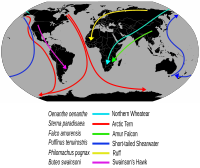
Photo from wikipedia
Abstract Dispersal affects the spatial distribution and population structure of species. Dispersal is often male‐biased in mammals while female‐biased in birds, with the notable exception of the Anatidae. In this… Click to show full abstract
Abstract Dispersal affects the spatial distribution and population structure of species. Dispersal is often male‐biased in mammals while female‐biased in birds, with the notable exception of the Anatidae. In this study, we tested genetic evidence for sex‐biased dispersal (SBD) in the Swan Goose Anser cygnoides, an Asian endemic and IUCN vulnerable species, which has been increasingly restricted to breeding on Mongolian steppe wetlands. We analyzed the genotypes of 278 Swan Geese samples from 14 locations at 14 microsatellite loci. Results from assignment indices, analysis of molecular variance, and five other population descriptors all failed to support significant SBD signals for the Swan Goose at the landscape level. Although overall results showed significantly high relatedness within colonies (suggesting high levels of philopatry in both sexes), local male genetic structure at the 1,050 km distance indicated greater dispersal distance for females from the eastern sector of the breeding range. Hence, local dispersal is likely scale‐dependent and female‐biased within the eastern breeding range. These findings are intriguing considering the prevailing expectation for there to be female fidelity in most goose species. We suggest that while behavior‐related traits may have facilitated the local genetic structure for the Swan Goose, several extrinsic factors, including the decreasing availability of the nesting sites and the severe fragmentation of breeding habitats, could have contributed to the absence of SBD at the landscape level. The long‐distance molt migration that is typical of goose species such as the Swan Goose may also have hampered our ability to detect SBD. Hence, we urge further genetic sampling from other areas in summer to extend our results, complemented by field observations to confirm our DNA analysis conclusions about sex‐specific dispersal patterns at different spatial scales in this species.
Journal Title: Ecology and Evolution
Year Published: 2020
Link to full text (if available)
Share on Social Media: Sign Up to like & get
recommendations!